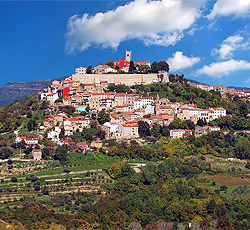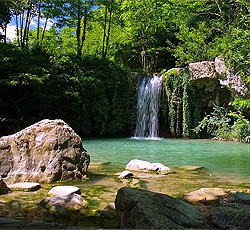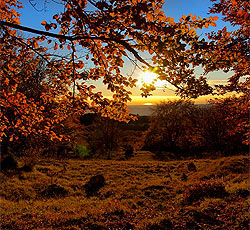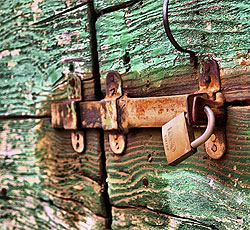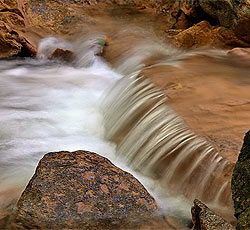-
Motovun (Central Istria)
Motovun is a town in central Istria, located on top of a steep hill that dominates the Mirna River valley. A staircase of 1052 steps leads up to it. Its basic aspect has changed very little since the medioeval times. The town walls are almost intact, the circular urban structure being adjusted to the hill configurations. From the top there is a view spreading over vineyards and fields of the Motovun forest, which belong in the category of Forest Parks.
Motovun Info -
Gologoricki Dol (Central Istria)
Gologrčki Dol is located in a valley, among the beautiful hills of the central Istria. Only 5 kilometers far from Cerovlje, you can enjoy in an untouched nature, a mild climate and hospitality of the local people.
Gologoricki Dol Info -
Oprtalj and Butori Ponor (Central Istria)
Gologrčki Dol is located in a valley, among the beautiful hills of the central Istria. Only 5 kilometers far from Cerovlje, you can enjoy in an untouched nature, a mild climate and hospitality of the local people.
Gologoricki Dol Info -
Draguc (Central Istria)
Behind seven hills, in the deepest inland of Istra, half way between Pazin and Buzet suddenly emerges - Draguć. Placed in the middle of nowhere, squeezed on the ridge of a hill, it simply fascinates with its harmonious ancient perspective. Due to the fact that many movies have been filmed here and various film stars have walked its streets Draguć has been for long babbled the name of – Istrian Hollywood.
Draguc Info -
Zarecki krov (Central Istria)
Zarečki krov is a spacious cave, which resembles a roof over which river Pazinčica on its course creates ten meters tall waterfall and lake. It’s one of the most interesting natural attractions of the valley Pazinčica. It is located 3 km from Pazin towards Cerovlj. During the summer months the local people find a place to swim and refreshments. The surrounding walls are decorated as climbing routes prized among climbers.
Zarecki krov Info -
Svetvincent (Central Istria)
The medieval town Svetvinčenat, located in the south of the central part of Istria on the road Pula – Pazin. Named after the Benedectine abbey of St.Vincent of the 10century. Ancient core of the town with tower and splendid renaissance town square deserves a look. In the summertime in Svetivinčenat are held various manifestations in extraordinarily attractive historical locations of this little town.
Svetvincent Info -
Groznjan (Central Istria)
Grožnjan, an ancient town in northwestern Istira, 15 km from the sea, has a lot to show of its wealth of tradition, cultural heritage and natural beauty, all of which is praised by art. Today, numerous cultural and historical landmarks serve as backdrops for cultural manifestations and entertainment. Here you can attend frequent concerts of classical music, jazz festival, the painting manifestation Ex Tempore, and numerous exhibitions at the municipal gallery.
Groznjan Info
Central Istria, Travel Guide for holidays in Central Istria
Central Istria History
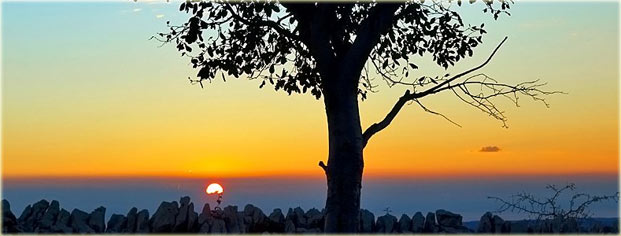 The Central Istria Riviera, known as Green Istria, embraces a multitude of small places with a long history and fortresses on hills with picturesque bell towers. Central Istria, as the administrative center of Pazin, “the heart of Istria,” will take you through its labyrinth of narrow streets and paths (suitable for cyclists) through the fascinating landscape of cultural and natural resources: medieval castles on the hills, forest of truffles, vineyards where tasty Malvasia and Teran ”grow” and olive groves which olive oil is known since antiquity.
The Central Istria Riviera, known as Green Istria, embraces a multitude of small places with a long history and fortresses on hills with picturesque bell towers. Central Istria, as the administrative center of Pazin, “the heart of Istria,” will take you through its labyrinth of narrow streets and paths (suitable for cyclists) through the fascinating landscape of cultural and natural resources: medieval castles on the hills, forest of truffles, vineyards where tasty Malvasia and Teran ”grow” and olive groves which olive oil is known since antiquity. Almost every hill in Central Istria has hidden fortress remains on its top. The photogenic Motovun can compete with the beauty, history and interesting historical sites of Oprtalj – a unique bell tower of the church of St. George in the form of square towers and many stone churches from different periods. Grožnjan pictures the mythical medieval towns, bringing a touch of art with its 18 galleries and art studios, the summer International Film School. The surrounding fields and hills “oversee” Buje which were called “the watchman of Istria” because of the postition. Sv.Petar u Šumi, Guran and Kanfanar give the impression that they come from some long-past times.
Central Istria Culture
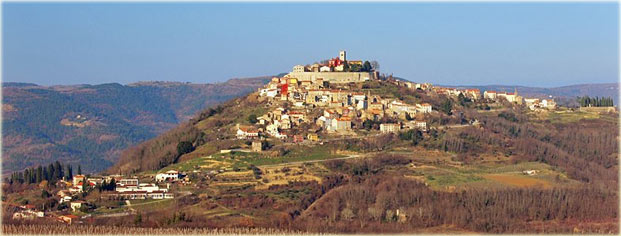 Any of the main roads from the eastern, western or southern Istrian coast will take you to Pazin. It is the administrative headquarters of the Istrian County, situated at the very center of the Istrian peninsula. The Pazin fortification Kaštel is elevated above the Pazinčica River, a spectacular cavity, a natural phenomenon placed under special protection. From this fortification, Pazin County – feud of the Habsburgs – used to be governed. This is, certainly, the most beautiful example of the evolution of karst hydrography. French writer Jules Verne has even placed part of the action of his novel “Mathias Sandorf” here. Today Kaptel serves as a home for the Ethnographic Museum of Istria and the Pazin City Museum.
Any of the main roads from the eastern, western or southern Istrian coast will take you to Pazin. It is the administrative headquarters of the Istrian County, situated at the very center of the Istrian peninsula. The Pazin fortification Kaštel is elevated above the Pazinčica River, a spectacular cavity, a natural phenomenon placed under special protection. From this fortification, Pazin County – feud of the Habsburgs – used to be governed. This is, certainly, the most beautiful example of the evolution of karst hydrography. French writer Jules Verne has even placed part of the action of his novel “Mathias Sandorf” here. Today Kaptel serves as a home for the Ethnographic Museum of Istria and the Pazin City Museum. If you move from Pazin to the north, in only twenty minute’s time, you will end up in lovely Motovun, most important inhabited place of these parts since prehistory. This picturesque mediaeval town placed on a hill, has a wealthy cultural and historical heritage. It rules over the valley of the Mirna River and the popular Motovun wood, a habitat of the best truffle in the world.
Keep moving upstream towards Buzet, a town placed on a hill in the middle of the fruitful valley of the Mirna River. Populated already in prehistory, it was fortified during the Roman rule. The central square with the parochial church of the Blessed Virgin Mary’s Assumption, is the very core of the old town. While here, be sure not to miss a visit to the County Museum of Buzet and its surroundings. In 1999, Buzet was publicly proclaimed the town of truffle, unique fruit of this mystical land.
You should also visit Roč, a significant cultural center, as well as Hum – the smallest town in the world. Between these two small towns there is a unique memorial alley dedicated to the old Croatian Glagolitic alphabet and culture. In only a few hours, one of many hiking paths can take you from the picturesque mediaeval architecture over the wooded hills of the Cicarija upland to the highest Istrian mountain and park of nature, Učka (1396m). It is one of the last European places where a patient eye of a bird lover will be compensated with impressive silhouette of the griffon vulture or the golden eagle.
If you move from Pazin towards the south, you will find yourself in Žminj, a small town where old Istrian houses and holdings now serve for agritourism. Here you can get accommodation and enjoy the homemade Istrian cooking and the unspoiled nature.
If you keep moving further to the south, you will come to Svetvinčenat, the art center of southern Istria. It is placed on the karst upland and surrounded by woods, pasture grounds and vineyards. Kaštel, the churches and the beautiful Renaissance square form a perfect scenography for supreme art events. Your thirst for cultural atmosphere will thus be fulfilled.
Central Istria – Things to do
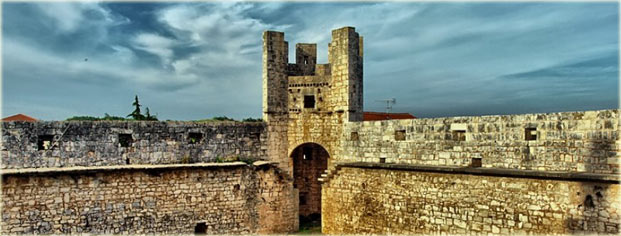 In Kastelir Labinci is kept a collection of ethnological treasures of Vittorio Rossoni which will reveal that the old Istrians were engaged in farming and cattle breeding. This is not surprising since Central Istria is a famous gastronomic destination. This is confirmed by numerous native delicacies: truffles, smoked ham, pasta, omelets, soup, the awarded Istrian wine – Malvasia and Teran and Muscat and of course unavoidable olive oil which is known since antiquity for the high quality. You can taste the delicious local specialties on the numerous events so do not miss the fair of Istrian white truffles in Livade, The Soup Fest in Gračišće or search for a family-farms in Jadruhi, Ročko Polje and other places where the labyrinth of Istrian wine and olive oil roads will bring you to.
In Kastelir Labinci is kept a collection of ethnological treasures of Vittorio Rossoni which will reveal that the old Istrians were engaged in farming and cattle breeding. This is not surprising since Central Istria is a famous gastronomic destination. This is confirmed by numerous native delicacies: truffles, smoked ham, pasta, omelets, soup, the awarded Istrian wine – Malvasia and Teran and Muscat and of course unavoidable olive oil which is known since antiquity for the high quality. You can taste the delicious local specialties on the numerous events so do not miss the fair of Istrian white truffles in Livade, The Soup Fest in Gračišće or search for a family-farms in Jadruhi, Ročko Polje and other places where the labyrinth of Istrian wine and olive oil roads will bring you to. Central Istria – Entertainments and events
Wine and olive oil roads have in the recent times dominated cyclists who have more than 2000 km of trails to enjoy in rides on their own way, downhill competitions and numerous mountain-bike races, while discovering the magic Motovun forests and medieval town Dvigrad abandoned in the 17th century. The path will lead you to the cave Baredine where you will be at 132m depth and can cool from the summer heat.”Night Birds” can enjoy at the Motovun Film Festival, where the art works of the Seventh art are displayed 24 hours a day and in the observatory in Višnjan which was founded by a group of amateurs and turned it into one of the twelve most productive observatories in the world.
Central Istria – Service Information
Regional Number Code 052
Police Department 192;
Fire Department 193;
Emergency 194;
Bus Station 624-364;
Airport Pula 550-900;
Ambulance 624-643;
Harbour/Ferry 811-132;
Tourist Office 622-460;
Railway Pula 541-733;
General Information 981.
Central Istria – How to reach us
You can reach Central Istria from many directions like: by bus which is connected through the whole Croatia; by train where the nearest train stations are in Rijeka or in Pula; by airplane where the nearest ports are on the Island Krk and in Pula; by boat which connects you with all the ports along the Istrian coast and its main port Pula; by personal vehicle with you can arrive from any direction and is the most secure and independent way of traveling.

